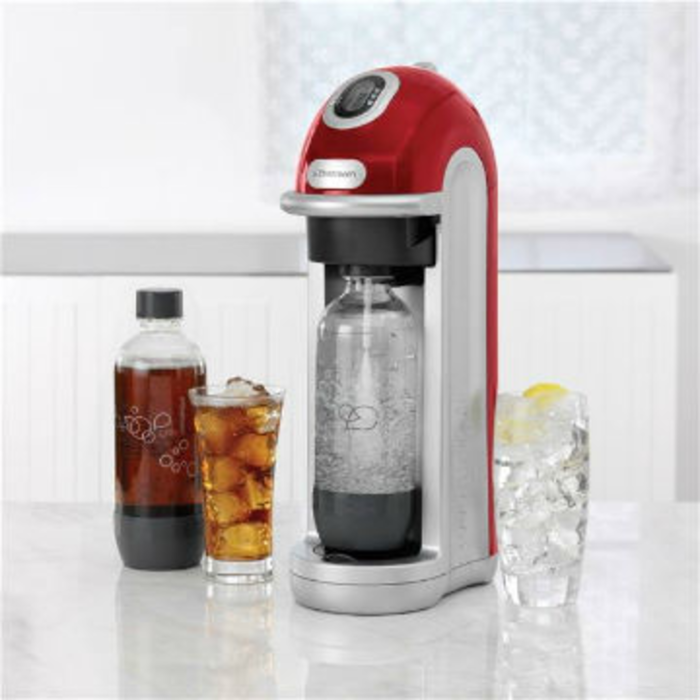Breaking a habit is never easy, especially in marketing. SodaStream, a provider of at-home soda makers, needed to have consumers shift from simply popping a can to creating their own carbonated beverages. To get consumers to envision what it would be like to have a soda maker in their home, SodaStream implemented House Party’s Reality Advertising—a solution that leverages user generated content as creative for paid media—as part of a digital test campaign.
The campaign launched in mid-September and ran for five weeks until mid-October. Consumers could opt-in to upload media directly onto House Party’s platform, says Michael Hermus, chief product and technology officer for House Party. The platform provider then sifts through the images and selects media to create digital ads, or in SodaStream’s case, Facebook ad units. Hermus says these ads are then uploaded onto House Party’s Facebook ad platform, which allows House Party to optimize the campaign and determine which copy and creative perform best.
The campaign ads drove consumers to a landing page where they could either use the microsite’s store locator to find where they could purchase SodaStream’s products or submit their email address to receive news and updates from the company. Kristin Harp, U.S. marketing manager for SodaStream, says the campaign’s goals were to analyze the number of searches executed via the store locator, as well as to build the brand’s mailing list so SodaStream could communicate with its customers over time. She adds that SodaStream’s target audience, moms between the ages of 25 to 54 who have an affinity for carbonated beverages, already comprise 40% to 50% of SodaStream’s Facebook community.
SodaStream had worked with House Party for word-of-mouth campaigns in the past and had also run its own Facebook ads separately. However, Harp says using House Party’s Reality Advertising solution for its Facebook news-feed ads would give it a “leg-up” in terms of how consumers perceived SodaStream’s ads.
“We really were attracted to the idea of consumers seeing themselves within the ads and seeing a soda maker at someone’s party [or] a soda maker on someone’s counter top,” Harp says. “[This] really provides that contextual normalization that ‘yes this could be a part of my everyday life.'”
Because marketers can measure a number of different variables with Facebook ads, House Party and SodaStream wanted to make sure that is was measuring “apples to apples,” Hermus says. So House Party created two sets of ad creative: One set featured user-generated content and the other featured traditional SodaStream creative. Hermus says that other variables, such as targeting, copy, format, and timing, were the same.
The user-generated ads produced better results. Compared to the ads featuring standard SodaStream creative, ads featuring user-generated content had a 76% higher click-through rate, a 136% higher engagement rate (including page likes, post likes, and photo views), a 313% higher photo viewing rate, a 34% higher post-like rate, and a 23% higher page-like rate. Harp says SodaStream did also a see a lift in sales; however, she says that it’s difficult to associate the lift with the House Party solution because the brand was running other digital campaigns simultaneously and because the brand typically sees a lift in sales around that time of year anyway. However, she did note that SodaStream was able to connect a great deal of store searches to the campaign.
“The biggest value is consumers starting to see themselves in a SodaStream context. They recognize themselves in these ads and they latch onto the idea that ‘normal people like me have soda makers in their home,’” Harp says. “It really helps us drive penetration of the product, and it goes a long way to making this category [and] this new product part of an American’s everyday life.”
But Harp says letting the consumer take the lead on the creative wasn’t so easy.
“The biggest thing for me to overcome as a marketer is letting go of how my brand should look,” she says. “As an end marketer you think of your content in a certain way, and you want it to have a certain look and feel. [With the user-generated content] it’s not always exactly how you would set up a shot, or how you would arrange the flavors, or how you would style the models. it’s all authentic and it’s all genuine and real.”
Harp adds that SodaStream will continue to work with House Party on future campaigns and that she would like to try experimenting with non-native formats, such as including user generated content in a banner ad.








